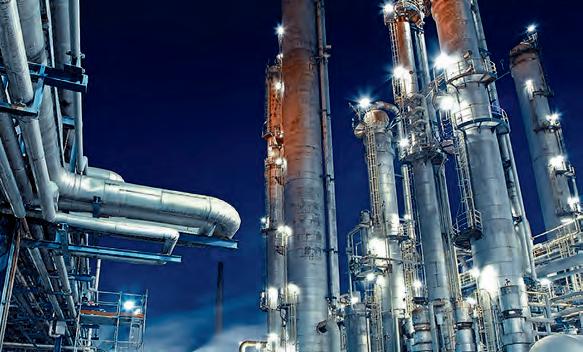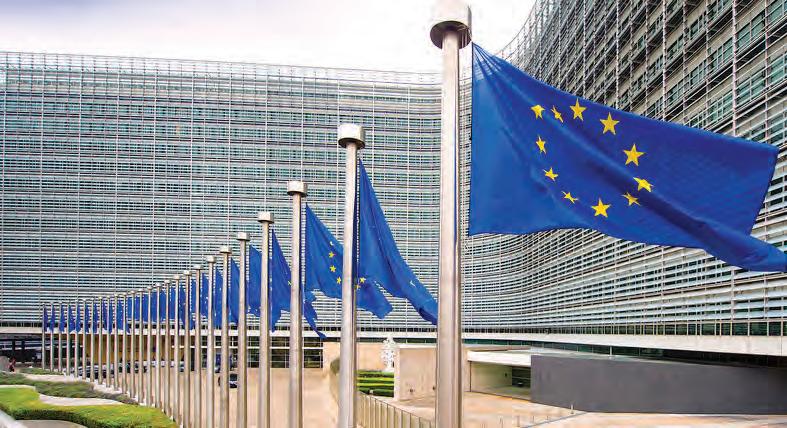
15 minute read
News Update
Green finance centre for Leeds and London
Advertisement
The government is to make available £10m funding for new green finance research hubs in a bid to position Leeds and London as “global centres for green finance.”
The new UK Centre for Green Finance and Investment will begin work in April 2021. The physical hubs will open their doors several months later, led by a number of UK institutions including the University of Oxford, the University of Leeds and Imperial College London.
Energy minister Anne-Marie Trevelyan said the UK won’t reach its net-zero target without “mobilising private capital and unleashing the power of the free market,” adding the new hubs will encourage financial services to “turn the tide of their investments and focus on sectors and companies that have a smaller environmental footprint.”
The hubs will provide data and analytics to financial institutions and services such as banks, lenders, investors and insurers around the world to better support their investment and business decisions by considering the impact on the environment.
The UK Centre for Green Finance and Investment will provide banks with the latest environmental and scientific intelligence to help companies of all sizes anticipate and adapt to the risks posed by climate change, the government said, adding that the research will also help to create new products and services that tackle climate change.
It is hoped the two hubs will attract and develop new green finance talent from around the world.
GREEN HOMES GRANT
Treasury takes back unspent funds
The government’s Green Homes Grant scheme will continue in England during the next financial year. But the intention remains that all unspent grant money allocated for this year -reckoned to be worth over £1,000m - will be returned to the Treasury at the end of this month. This leftover sum would not be ring-fenced for any future energy saving programmes.
The scheme offers subsidy grants of up to £5,000 to individual householders, covering up to twothirds of the costs of installing a limited range of renewable energy and energy-saving devices.
A fortnight before the March 3 budget, headlines in the Times newspaper had announced that Chancellor Rishi Sunak (right) would be announcing the scrapping of the entire scheme from this April. This prompted an outpouring of protests from a wide variety of sources. These included the House of Commons Environmental Audit Committee, the Sunak made no reference at all to the scheme. This means that the £320m budget he announced last December for the scheme for the financial year 2021/2022 is set to go ahead.
According to Prime Minister Boris Johnson, the main reason why so many fewer homes would benefit than anticipated from this “Build Back Better” scheme - which he touted to the United Nations - was because of lack of consumer demand, largely owing to COVID-19 fears.
Others have ascribed the slow progress to incompetent administration, the limited range of accepted products, and the scarcity of registered installers. Business Department officials had rejected proposals to utilise existing accreditation schemes overseen by established trade associations. Instead, they insisted that any installers wishing to participate would be required to join the previously obscure Trustmark scheme.
Trades Union Congress, the entire environmental movement, insulation and solar industry businesses, the Liberal Democrats and the Labour Party, plus a range of newspaper editorials. It also incurred the wrath of the Committee on Climate Change’s influential chairman, Lord Deben.
Most concentrated upon the fact that only 30,000 homes had yet been improved. Last July, Sunak had promised that his £2bn programme would benefit 600,000 homes and generate some 100,000 jobs.
In the end, in his budget speech,
Trevelyan takes the reins as Kwarteng moves up
The promotion of energy minister Kwasi Kwarteng to the Cabinet as Business Secretary of State has led to the appointment of a new minister, Anne-Marie Trevelyan (left). She now oversees Business, Energy and Clean Growth. A graduate of Oxford Poly and then a chartered accountant with PwC, Mrs Trevelyan became an MP in 2015, winning Berwick upon Tweed from the Liberal Democrats, who had held it for 42 years. Her previous Ministerial experience was as a Defence Minister, and then as Secretary of State for International Development. Last year she was put in charge of adaptation and resilience policies pertinent to the COP26 in Glasgow.
She left the Cabinet last September when that Department was closed, but returned this year as a Minister of State, an unusual demotion. Prior to her appointment, she was a vocal supporter of gas fracking, and of Brexit.
Also heavily involved as an energy minister is the former MEP for north-east England (including Berwick) Lord Malcolm Callanan, particularly as there are many members of the Upper House concerned about energy saving policy
The Labour team is headed up by Doncaster MP Ed Miliband, party leader between 2010 and 2015. He is supported by Southampton MP Dr Alan Whitehead, a former buildings minster, and Greenwich’s Matthew Pennycook, a former chairman of the influential parliamentary. Renewable and Sustainable Energy Group, PRASEG.
The Liberal Democrat spokesperson is Richmond upon Thames MP Sarah Olney, and shadowing energy and climate change for the SNP is Kilmarnock’s Alan Brown.
First UK homes fuelled by hydrogen set for to be built in the north east
The UK’s first homes with household appliances fuelled entirely by hydrogen are set to be built in Low Thornley, Gateshead, providing the public a glimpse into the potential home of the future where no carbon emissions are released.
The two semi-detached homes, funded with the help of the UK government’s Hy4Heat Innovation programme, will open in April 2021, showing how hydrogen has the potential to be used as a clean replacement to natural gas in the home.
The hydrogen houses are intended to have a three-year lifespan, but potentially longer, up to ten years. They are not intended to be habitable, but to showcase the use of hydrogenfuelled applications in a real-world domestic setting.
The hydrogen house project is aligned with a larger scheme detailed in the Prime Minister’s Ten point plan which also includes establishing a Hydrogen Neighbourhood, and to the development of plans for a potential Hydrogen Town before the end of this decade.
The houses will use 100 per cent hydrogen for domestic heating and cooking in appliances including boilers, hobs, cookers and fires.
Unlike natural gas, which is responsible for over 30 per cent of the UK’s carbon emissions, hydrogen produces no carbon at the point of use, with the only by-product being water.
news update
UK EMISSIONS TRADING
Concerns grow over new UK scheme
The UK emissions trading scheme officially came into force on January 1 to replace its EU counterpart, the EU ETS. It is designed to reduce greenhouse gas emissions by setting a cap on the levels heavy polluters can produce, forcing them to buy carbon credits to cover their annual output.
But the government is still only beginning talks with industry about key aspects of the scheme, which has not yet started trading. This lacuna has left many participants very concerned.
There are 14,000 sites occupied by energy intensive companies, all of which are waiting on the government for the date and details of the volume of carbon credits the UK government plans to sell during this first auction. The government is currently promising to hold the process at some point during the second quarter.
UK electricity producers are selling power without knowing the cost of the associated emissions. Typically, power producers sell electricity up to two years in advance. Before Brexit UK companies priced forward contracts linked to the cost of the EU scheme. All participants need to know precisely to what extent the scheme will be linked to the EU programme, the world’s largest, which would inevitably influence pricing. But Brussels has said formal talks with the UK on a link with the EU scheme had not yet begun.
It added the Brexit deal envisaged that the two sides would give “serious consideration” to linking the respective systems. But the government’s recent energy white paper, issued in December, has raised concerns in industry that may not happen. The policy document stated the UK was open to international linkages in general, without naming the EU specifically.
“I’m worried about the complete lack of a carbon price in the UK,” said Emma Pinchbeck, the head of Energy UK, told the Financial Times. She warned there was a risk that volatility gets passed on to consumers in higher prices.
Many UK power producers have already purchased EU credit in the expectation the schemes will be linked. “Our carbon price is unknown, and the market is operating on the assumption that we are going to link with the EU,” she added.
The lack of trading of carbon credits has caused pent up demand and Louis Redshaw of Redshaw Advisors, a London-based carbon consultancy, said the delay risked a “massive” price spike. The UK government has set a price floor of £22 per tonne but this is still below the current price of an EU allowance, which recently surged to a record high of over €40 per tonne.
“There will be more buyers than sellers on the first auction,” said Redshaw. The situation is “a car crash in slow motion,” he warned.
Iwan Hughes, head of policy at VPI Generation, said the huge uncertainty made it difficult for power companies to know whether or not to operate their power plants. “Without a UK carbon market, neither industry nor gas power generators know their marginal cost to operate,” he said.
In a statement, the UK government said that its scheme was “more ambitious” than the EU scheme. It said it would “soon consult” on how the scheme would “align with our worldleading net zero target”.

Carbon dioxide emissions rebound after record fall
The Covid-19 crisis in 2020 triggered the largest annual drop in global energy-related carbon dioxide emissions since the Second World War, according to the International Energy Agency. However, the overall decline of about 6 per cent masks wide variations depending on the region and the time of year.
Global emissions plunged by almost 2bn tonnes in 2020, the largest absolute decline in history. Most of this – around 1bn tonnes, which is more than the annual emissions of Japan – was due to lower use of oil for road transport and aviation.
After hitting a low in April, global emissions rebounded strongly and rose above 2019 levels in December. The latest data show that global emissions were 2 per cent or 60m tonnes, higher in December 2020 than they were in the same month a year earlier.
Major economies led the resurgence as a pick-up in economic activity pushed energy demand higher and significant policies measures to boost clean energy were lacking. Many economies are now seeing emissions climbing above pre-crisis levels.
“The rebound in global carbon emissions toward the end of last year is a stark warning that not enough is being done to accelerate clean energy transitions worldwide,” said Dr Fatih Birol (pictured), the IEA Executive Director. “If governments don’t move quickly with the right energy policies, this could put at risk the world’s historic opportunity to make 2019 the definitive peak in global emissions.
IN BRIEF
Government ‘must boost green skills’
Government must do more to boost training in the green skills sector to prevent the UK missing its net-zero target, according to a report from the Institute for Public Policy Research.
The research finds that there is a lack of leadership on the issues of skills and employment, at all levels of government, and industry.
Government must take the green skills crisis seriously, says the IPPR, investing in further education, and matching its net-zero ambitions with investment in decarbonisation. Industry must give the issues of skills and employment a seat at the table in board-level decision making, and make radical changes to ensure the construction sector is an attractive place to work.
UK heat pump sales set to double
A survey of members by The Heat Pump Association reveals that the UK market is set to double this year.
The HPA, which represents around 95 per cent of the heat pump manufacturing market, says manufacturers have placed orders with their supply chains to deliver 67,000 units in 2021.
With 35,000 heat pumps sold in 2019, the near doubling of the market is a significant step in the right direction. The growth also closely aligns with the HPA’s road map to net zero, which called for 72,000 heat pump installations this year.
Hydrogen for cogeneration plant
For the first time in Belgium, hydrogen will be used in a commercial cogeneration plant designed to generate electricity and heat from natural gas.
The aim of the pilot project by INEOS and ENGIE is to replace natural gas with hydrogen used by the INEOS turbine. Initially, 10 per cent of the gas feed will be replaced by hydrogen. If this goes well this will be increased to 20 per cent. This is the first time such tests have been carried out on an industrial scale in Belgium. The CHP plant at the INEOS Phenol site in Doel, one of the first built in Belgium, has the ideal profile for this test.
news update
Industry lagging behind on emissions cuts
New research by the Transition Pathway Initiative finds that only 16 of 111 large publicly-listed industrial companies are aligned with an emissions reduction pathway that would keep global warming at 2°C or below. The combined market capitalisation of the 95 industrial companies failing to align with 2°C or below by 2050 is over $856bn. The sectors covered are mining, steel, cement, paper, aluminium, chemicals, and other industrials.
The Transition Pathway Initiative is a global, asset-owner led initiative which assesses companies’ preparedness for a low-carbon economy. The research was carried out for TPI by the Grantham Research Institute on Climate Change and the Environment at the London School of Economics.
The research analyses 169 companies including Arcelor Mittal and Rio Tinto. Of these 111 firms are analysed on carbon performance to show if their emissions reductions plans align with the Paris Agreement. The 111 companies come from the aluminium, cement, diversified mining, steel and paper sectors – collectively industries deemed ‘hard to decarbonise’ as there is no straightforward low-carbon replacement technology for their products or processes.
The TPI research highlights the poor performance of the aluminium and paper sectors in particular. Only one company in both sectors (Rio Tinto – specifically for aluminium) is aligned with a 2°C or below pathway by 2050. By contrast six steel companies are aligned by 2050 including the largest, Arcelor Mittal.
The sector’s performance is marginally more encouraging for climate- conscious investors from a 2030 point of view, with 22 per cent of companies aligned with 2°C or below for that shorter time frame (nine companies aligned in paper, eight in steel, five in diversified mining and four in cement by 2030). ENERGY-EFFICIENT RENOVATIONS PLAN
EU forges ahead with energy plans
European Union governments will rally behind the official plan to expand energy-efficient building renovations, according to a draft document. But they are not yet willing to explicitly endorse using any legally binding energy performance standards to ensure this occurs in all 27 countries.
The European Commission is encouraging European countries to use building renovations to improve energy performance in order to boost construction sector jobs and aid economic recovery from the coronavirus pandemic. The intention is to upgrade the worst energyguzzling buildings.
According to the initial plans issued last October, the overall objective is to more than double the annual rate at which EU buildings are renovated, in order to improve energy performance. Now the 27 EU countries are preparing their combined reactions to these proposals. A leaked draft of their response reveals that countries will fully endorse the call for a “massive increase in renovations, taking buildings towards nearly zero-energy levels.”
The EU’s €750bn COVID-19 recovery fund offers a “crucial opportunity” to increase renovations, the 27 Governments are set to state. It is agreed that renovation support for homeowners and businesses should be expanded through green bonds, loans and tax incentives.
However, the draft document is not explicitly backing a key part of the Commission’s plan. It recommended the introduction of statutory EU minimum energy performance standards for existing buildings.
If the Governments do not explicitly endorse these legally binding proposals, the Commission will likely seek to return to the proposal later this year. It is acknowledged to have strong backing from the European Parliament. The aim would be to set a date, years in advance, when the standards would become binding, to push building owners to upgrade properties to comply.
The draft response agrees that linking minimum energy performance standards to renovations “may, in particular if accompanied by training and qualification schemes for building professionals, be an efficient way of ensuring more extensive renovations.”
If the EU wants to raise its renovation rate, there is “no alternative” to using mandatory minimum energy performance standards, said Brook Riley, head of EU affairs at insulation manufacturer Rockwool Group.

Low-carbon hybrid system goes on trial across the UK
A low-carbon hybrid heating system is being trialled in seven homes in Wales, London and the south and east of England.
The ‘HyCompact’ project, a collaboration between Wales & West Utilities and electricity network operator UK Power Networks will fit the single-unit hybrid system in customers’ homes to supply their heating through both electricity and natural gas.
The new hybrid units contain a gas boiler and an electric air source heat pump alongside smart control software. The system, hung on the wall in place of the existing conventional gas boiler, can flexibly switch between using renewable electricity, when it’s available, and green gas at other times – enabling the full decarbonisation of heat with switching driven by cost and carbon.
The project aims to demonstrate how low-carbon heating systems that combine gas and electricity can be easily ‘retrofitted’ and reduce carbon emissions from millions of homes and businesses with traditional gas boilers. According to a 2019 report by the government’s Committee on Climate Change, as many as 29m homes require such an upgrade if the UK is to meet its Net Zero target by 2050.
The project builds on Wales & West Utilities’ Freedom Project, which trialled the use of hybrid heating systems with a standalone gas boiler and an external air-source heat pump. Taking on board customer feedback from that trial, HyCompact is using the latest advances in hybrid heating technology to test a next generation product.
The project is running through winter and spring 2020-








